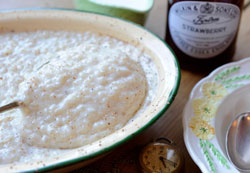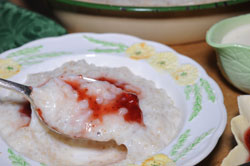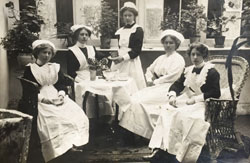Hello, darlings!
Welcome to another spiffing collaboration!

My dear culinary amour Mrs Simkins and I had such blast working together last year on our summer garden party and Italian escapades, that we couldn’t wait to get cracking on yet another exciting collaboration – you see, we only have eyes for each other, in a culinary capacity, of course!
So here we are again, rearing to go and full of beans, in readiness to deliver an extraordinary menu of temptingly satisfying old-fashioned recipes – the very best of British fayre, and beyond the borders, if we fancy experimenting with a different type of cuisine.
Darlings, I must divulge there’s one slight difference with our new collaboration, is that Mrs Simkins and I extend an invitation to all those culinary enthusiasts of yesteryear to join us in our delightful homes, well I mean respective kitchens’, where you’ll learn how to recreate a mouth-watering slice of food history – I say, would you care to accept our invitation?
Miss Windsor X
Hello, darlings!
Miss Windsor excitedly presents Mrs Beeton’s Hasty Pudding (Nutmeg & Vanilla Tapioca Pudding).
Okey dokey, Miss Windsor has no time for ‘dilly dallying’, so without further ado I’m going to get straight to the point – chop, chop! about this subtly sweet yet rather wholesome member of the British milk pudding family.
You see, as far as I know, hasty pudding or more commonly known as tapioca pudding has been a staple of our beloved sweet course since the 1800’s – well, a lot less so in today’s modern world, but suffice to say it’s certainly making a glorious comeback!
Oh, and I must quickly mention that I’m ‘chomping at the bit’ as I excitedly present this recipe as my first offering to ‘At Home With Mrs Simkins and Miss Windsor’ – our new collaboration which opens with an all guns blazing HASTE-OFF, hence HASTY PUDDING – comprende?
Darlings, and if you haven’t already guessed, just as it says on the tin we are indeed rustling up a quick-fire pudding that you can recreate in a jiffy, or in a haste in this case – just twenty minutes will do the trick! Created with t apioca (of course!) milk, brown sugar, vanilla flavouring, and nutmeg – the very best of British fayre! In fact, my darling Mrs Simkins opted to make a baked version with flour, milk, brown sugar, butter, egg, and nutmeg – How spiffing! She has also made an American version with cornmeal: what versatility!
apioca (of course!) milk, brown sugar, vanilla flavouring, and nutmeg – the very best of British fayre! In fact, my darling Mrs Simkins opted to make a baked version with flour, milk, brown sugar, butter, egg, and nutmeg – How spiffing! She has also made an American version with cornmeal: what versatility!
Now, moving swiftly on, hasty pudding which was traditionally made with either sago or tapioca and sometimes with oatmeal, has been quite a thing in England since the late sixteenth century. In fact, the Victorians absolutely adored this scrumptious, easy on the purse strings, economical dish which was a rather appreciated delicacy of its time – of course, one would serve this delightful pud with a splash of cream and a dollop of jam – I’m rather fond of Tiptree Strawberry Jam by Wilkin & Sons Ltd.
So, if you’re a fan of old-fashioned traditional British food such as rice pudding, then you’re going to fall head over heels with this old-school, traditional creamy dessert bestowed the grand title of Mrs Beeton’s Hasty Pudding (Nutmeg & Vanilla Tapioca Pudding) - just like granny used to make! Or I dare say, many of you have wonderful memories of something similar yet equally indulgent which your school cook would whip up to perfection – school dining at its best!
Now, to be brutally honest, when I was a snipper I was rather averse to tapioca pudding, and I used to dread the day it was on the school dinner menu. I couldn’t even bear to blink an eye at it, as it reminded me of a sloppy gooey bowl of white jelly balls that had been torn from the depths of a slippery slimy pond – frogspawn comes to mind!
I must say, my beloved culinary marvel, Mrs Beeton was a huge fan of tapioca, and states in her culinary masterpiece Beeton’s Book of Household Management which was first published in 1861, ‘Its nutritive properties are large, and as a food for persons of delicate digestion, or for children, it is in great estimation’ – well versed, Mrs Beeton! Of course, recipes for hasty pudding, tapioca pudding, tapioca milk-based pudding, plus tapioca soup were given pride of place in her culinary bible.
Darlings, hurry along now; there’s no time to spare, as one must prepare to recreate Mrs Beeton’s Hasty Pudding. However, before you get cracking I’m afraid to say that you’ve been a trifle misled, as you’re going to need a bit longer than twenty minutes; in fact, twelve hours to be precise!
You see, one must soak the tapioca pearls for at least twelve hours in water (some say a couple of hours will do, but don’t listen to them!) in order soften the pearls which will thicken the mixture. Oh, and by the way, do not succumb to the convenience of instant tapioca, the instant type doesn’t work so well, and in any case, Miss Windsor will not tolerate idle hands!
Oh, dearie me, I expect the news has ‘upset the applecart’, so to speak, but the truth is darlings Mrs Beeton’s recipe is not so hasty at all! I’m afraid there’s nothing Miss Windsor can do about that, as it’s due to the everyday challenges of cooking from the past, even if the recipe is deemed to be quick as a flash; some kind of modernish convenience of yesteryear, I suppose!
Darlings, tick tock, tick tock, hurry along now and put your skates on, and dash off to your kitchen and give your tapioca pearls a jolly good soaking – Ta very muchly!
See you back here in twelve hours – don’t be late!

Miss Windsor X
Preparation time: 12 hours to soak the tapioca, plus 10 minutes. Cooking time: 10 to 15 minutes Serves 6 delightful guests!
- 220g (1/2 cup) tapioca
- 1 litre (34 US fl oz.) water
- 750ml (26 US fl oz.) whole milk

- 100g (1/2 cup) brown sugar
- 1 tablespoon vanilla essence
- Pinch of salt
To Serve: double cream and strawberry jam
Equipage: vintage or decorative serving dish
Method
accept our invitation? 1. First off, soak the tapioca pearls in water for 12 hours – overnight will do the trick!
2. Darlings, now 12 hours have passed its time to wash your grubby little paws in readiness for some culinary action!
3. On a low heat slowly boil together the milk and vanilla essence in a large saucepan.
4. Then gently spoon in the tapioca and stir briskly.
5. Add a pinch of salt and brown sugar, then continue to cook on a low heat for 10 minutes or so until thickened. Stirring constantly.
6. Add a light sprinkling of flour if not thickened enough to your liking!

7. Once your pudding is ready pour into a vintage or decorative serving dish of your choice.
8. Serve immediately to your delightful guests with a splash of cream and a dollop of strawberry jam – voila!
Mrs Simkins says:
I just love those pretty bowls of Miss Windsor's and happen to know they once belonged to her Aunt, pictured in the photograph above. She's the one in white, second from right.